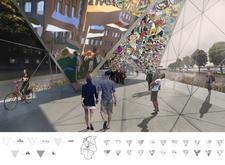5 key facts about this project
### Overview
The Baltic Way Memorial, titled "Equilateral," is a commemorative structure dedicated to the Baltic Way, a significant peaceful demonstration in 1989 advocating for the independence of the Baltic states—Estonia, Latvia, and Lithuania. Situated along a prominent urban axis, the memorial's design strategically emphasizes visibility and accessibility, inviting engagement from both local residents and visitors. The architectural intent merges functionality with symbolic significance, creating a landmark that resonates with historical meaning.
### Spatial Strategy
The design employs elongated triangular prisms that facilitate both structural integrity and artistic expression. This arrangement fosters a rhythmic flow across the site, promoting movement through and around the memorial. The spaces created between the triangular forms engage visitors, encouraging personal exploration and interaction within the memorial. Pathways are integrated to connect various areas, enhancing user immersion and creating a participatory experience that embodies the memorial's commemorative purpose.
### Materiality and Sustainability
The selection of materials plays a critical role in articulating the design’s conceptual framework. Extensive use of glass in the triangular panels allows for transparency and a dynamic interplay of light, symbolizing openness and vulnerability. A steel frame provides essential structural support while maintaining a lightweight aesthetic. The inclusion of colorful acrylic panels imbues vibrancy into the design, reflecting the cultural diversity of the Baltic nations. Concrete serves as a robust foundation, anchoring the memorial within its urban context.
The surrounding landscape incorporates native flora to promote biodiversity and visual harmony. This sustainable approach enhances the memorial's environmental integration, creating a serene refuge amidst the urban environment. The repeated triangular geometry within the design reinforces themes of unity and solidarity, symbolizing the collaborative spirit of the Baltic states during the historic demonstration.





















































